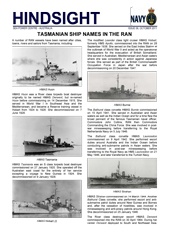Hindsight: Tasmanian ship names in the RAN

PDF : 482.46 KB
A number of RAN vessels have been named after cities, towns, rivers and sailors from Tasmania, including:
HMAS Huon was a River Class torpedo boat destroyer originally to be named HMAS Derwent, but renamed Huon before commissioning on 14 December 1915. She served in World War I in Southeast Asia and the Mediterranean, and became a Reserve training vessel in Hobart from 1924 to 1928. She decommissioned on 7 June 1928.
HMAS Tasmania was an S Class torpedo boat destroyer commissioned on 27 January 1920. She operated off the Australian east coast for the entirety of her service excepting a voyage to New Guinea in 1924. She decommissioned on 9 January 1928.
The modified Leander Class light cruiser HMAS Hobart, formerly HMS Apollo, commissioned into the RAN on 28 September 1938. She served on the East Indies Station at the outbreak of World War II and acted as the operational headquarters for the evacuation of British Somaliland. She served in Australian, Mediterranean and Asian waters where she was consistently in action against Japanese forces. She served as part of the British Commonwealth Occupation Force in Japan after the war before decommissioning on 20 December 1947.
The Bathurst Class corvette HMAS Burnie commissioned on 15 April 1941. She served in Australian and Asian waters as well as the Indian Ocean and for a time flew the broad pennant of the famous Tasmanian naval officer, Commodore John Collins, RAN then Commodore Commanding the China Force. She was involved in postwar minesweeping before transferring to the Royal Netherlands Navy on 5 July 1946.
The Bathurst Class corvette HMAS Launceston (I) commissioned on 9 April 1942. She performed escort duties around Australia and the Indian Ocean before conducting anti-submarine patrols in Asian waters. She was involved in post-war minesweeping before transferring to the Royal Navy as HMS Launceston on 21 May 1946, and later transferred to the Turkish Navy.
HMAS Strahan commissioned on 14 March 1944. Another Bathurst Class corvette, she performed escort and anti submarine patrol duties around New Guinea and Borneo and, after the cessation of hostilities, was involved in minesweeping and anti-piracy patrols around Hong Kong. She decommissioned on 25 January 1946.
The River Class destroyer escort HMAS Derwent commissioned into the RAN on 30 April 1964. During her career Derwent deployed to South and Northeast Asia, New Zealand, India, Africa and the Middle East, including operational deployments with the Far East Strategic Reserve and to Vietnam as an escort for HMAS Sydney. In 1967 she assisted bushfire-fighting efforts in Tasmania. She decommissioned on 8 August 1994.
HMAS Hobart (II) was a Charles F Adams Class guided missile destroyer and commissioned into the RAN on 18 December 1965. She made three operational deployments to Vietnam and during her second deployment, on 17 June 1968, she was struck by three missiles mistakenly launched by a USAF F4 Phantom jet killing two crew members and injuring seven others. She deployed to South and Northeast Asia, North America, New Zealand, the Middle East, India, Europe and Africa, and provided civil assistance in Darwin in the wake of Cyclone Tracy. She decommissioned on 12 May 2000 being just the third RAN ship to steam more than one million nautical miles.
HMAS Launceston (II) was a Fremantle Class patrol boat and commissioned into the RAN on 1 March 1982. She served primarily in northern Australian waters contributing to to the nation's fisheries protection, immigration, customs and drug law enforcement operations. She decommissioned on 8 September 2006.
Three of the Collins Class submarine fleet have been named after Tasmanian sailors; Collins, named for Vice Admiral Sir John Collins, first Australian born Chief of Naval Staff; Dechaineux, named for Captain Emile Dechaineux, Commanding Officer of HMAS Australia and killed in action at Leyte Gulf; and Sheean, named for Ordinary Seaman Teddy Sheean, last seen defiantly firing his gun at Japanese aircraft as his stricken ship, HMAS Armidale, sunk beneath him. Collins was commissioned on 27 July 1996 while Dechaineux and Sheean were both commissioned on 23 February 2001.
HMAS Huon (II) was the first of six Huon Class mine countermeasures vessels commissioned for the RAN. She was commissioned on 15 May 1999 and is currently based at HMAS Waterhen in Sydney.
The Hobart Class destroyers (DDGH) currently under construction will be one of the world’s most capable all purpose warships. They will provide air defence for accompanying ships, land forces and infrastructure in coastal areas, and for self-protection against missiles and aircraft. The combination of air, surface and submarine combat capabilities ensure that the destroyers have the layered defensive and offensive capability required to counter conventional and asymmetric threats.
Sea Power Centre - Australia
Sea Power Centre - Australia
Department of Defence
Canberra ACT 2600
seapower.centre@defence.gov.au













